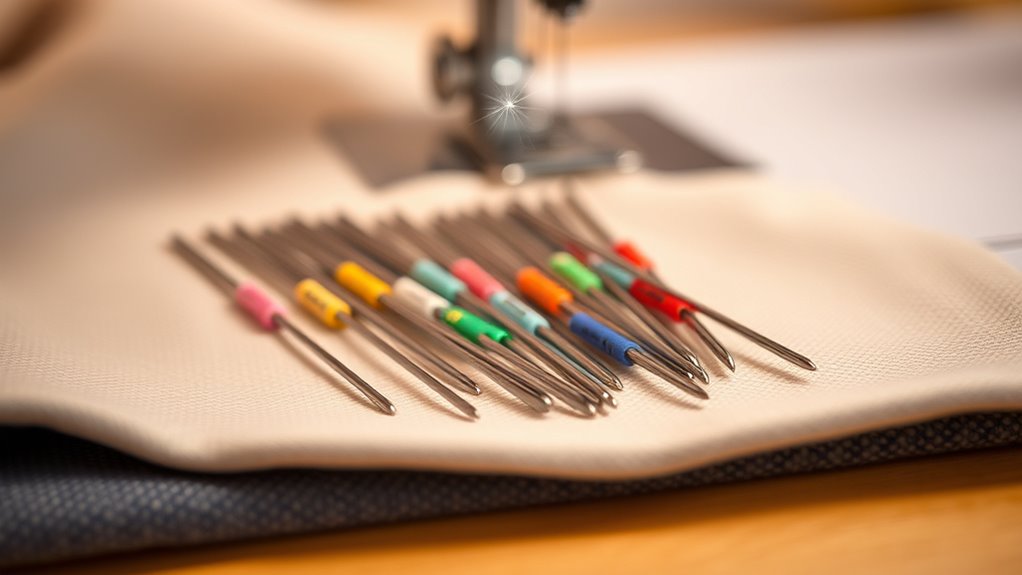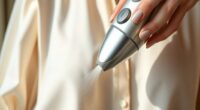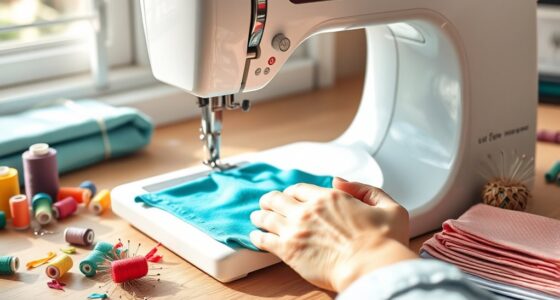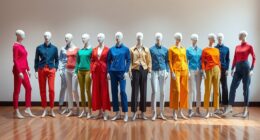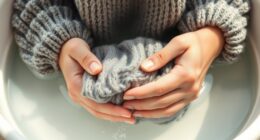To choose the right sewing machine needle for every fabric, consider the fabric type and thickness. Use fine needles (60/8 or 70/10) for lightweight fabrics like silk, and heavier needles (100/16 or 110/18) for denim or canvas. For stretchy fabrics, select ballpoint needles, and for leather or thick materials, opt for specialized needles. Matching the needle size to your fabric guarantees smooth stitches and fabric safety. Keep learning to discover more tips for perfect sewing results.
Key Takeaways
- Match needle size to fabric weight: fine needles for lightweight fabrics, larger for heavy-duty materials.
- Choose needle type based on fabric texture: sharp for woven, ballpoint for knit, specialty for leather or quilting.
- Ensure needle and thread compatibility: thicker threads need larger needles, finer threads need smaller needles.
- Test on scrap fabric to verify proper needle selection before sewing the main project.
- Follow manufacturer guidelines and adjust needle choice for specific fabric characteristics and project needs.
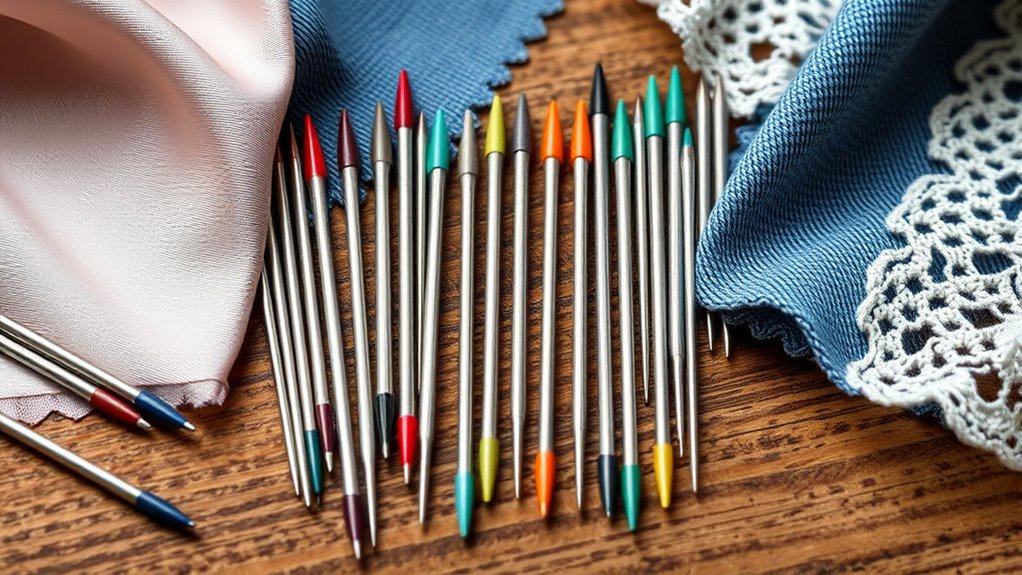
Selecting the right sewing machine needle is vital for achieving professional-looking results and preventing fabric damage. The key to successful sewing starts with understanding your fabric types and choosing the appropriate needle sizes. Different fabrics have unique characteristics, and using the wrong needle can lead to skipped stitches, puckering, or even tearing. For lightweight fabrics like silk or chiffon, you’ll want to select a fine needle, typically a size 60/8 or 70/10, because these fabrics are delicate and require less puncture force. Conversely, heavy-duty fabrics like denim or canvas need a sturdier needle, such as a size 100/16 or 110/18, to handle thicker fibers without breaking or bending.
When working with woven fabrics like cotton or linen, a standard universal needle size 80/12 usually works well because it can penetrate these materials smoothly without causing damage. However, if you’re sewing stretch fabrics like jersey or spandex, consider using a stretch or ballpoint needle that’s specifically designed to glide between the fibers without snagging or causing runs. For these, a size 75/11 or 90/14 is often recommended, depending on the weight and stretchiness of the fabric.
Keep in mind that fabric types influence not only the choice of needle size but also the type of needle you should use. For example, sharp needles are best for woven fabrics, while ballpoint needles are ideal for knits, as they prevent snags and runs. When working with specialty fabrics like leather or vinyl, you’ll need a leather or quilting needle, which has a more pointed tip to pierce dense materials cleanly. Matching the needle size to the fabric type ensures the stitches are even and the fabric remains intact. Additionally, understanding the concept of penetration force can help you select the correct needle, as fabrics with different thicknesses require varying levels of force for effective sewing.
It’s also vital to match your needle size to the thread you’re using. Thicker threads require larger needles, while finer threads need smaller needles. Always consult your sewing machine manual for the recommended needle sizes for your project, as using an incompatible needle can cause machine jams or skipped stitches. When in doubt, test on scrap fabric to see how the needle interacts with your chosen material. This small step can save you time and frustration, ensuring your stitches are even, strong, and professional-looking every time. By understanding fabric types and needle sizes, you’ll be well on your way to sewing with confidence and precision.
Frequently Asked Questions
Can I Use a Universal Needle for All Fabrics?
You can use a universal needle for most fabrics, but it’s not ideal for all. Universal needles are compatible with a wide range of fabrics, making them versatile, but for delicate or heavy materials, specific needle types work better. For example, sharp or ballpoint needles are best for knit or woven fabrics respectively. Always match the needle to your fabric for the best sewing results and to avoid damage.
How Often Should I Replace My Sewing Machine Needle?
A stitch in time saves nine, so you should replace your sewing machine needle regularly. For maximum needle longevity, change your needle after every 8-12 hours of sewing or after completing a project. Frequent replacement ensures smooth sewing, prevents skipped stitches, and reduces fabric damage. Keep an eye on the needle’s condition and replace it sooner if you notice bending, dullness, or rust. Regular updates keep your machine running at its best.
Do Needle Sizes Vary Between Brands?
Yes, needle sizes can vary between brands, so always check brand compatibility and needle markings before purchasing. Different brands may use slightly different sizing systems or markings, which can affect how well the needle fits your machine and performs with your fabric. To avoid issues, compare the markings on the needle package with your machine’s specifications and choose compatible brands for the best sewing experience.
Can a Wrong Needle Damage My Fabric?
Think of sewing as a dance, where the wrong needle is like an ill-fitting shoe. Using an incompatible needle can cause fabric damage, snagging or puckering your material. It’s vital to match needle compatibility to your fabric type; otherwise, you risk ruining your project. Always select the right needle size and type to keep your fabric safe and guarantee smooth sewing, just like a perfect dance partner.
Are Specialized Needles Necessary for Stretch Fabrics?
Yes, specialized needles are essential for stretch fabrics to avoid skipped stitches and fabric damage. Using the right needle compatibility, like ballpoint or stretch needles, ensures smooth sewing. Remember stretch fabric tips such as testing on scrap first and sewing slowly. These needles are designed to glide through stretchy materials without snagging, making your sewing easier and more professional-looking. Don’t omit this step for perfect results!
Conclusion
Now that you know how to select the perfect needle for each fabric, you’ll sew with confidence. For example, imagine you’re working on a delicate silk blouse; using a fine, sharp needle ensures smooth stitches without damaging the fabric. When you choose the right needle, your projects turn out professional and flawless. So, next time you start sewing, remember: the right needle makes all the difference, making your creative journey easier and more enjoyable.

